| Author |
Message |
|
Owen Bush
Industry Professional
|
 Posted: Wed 10 Feb, 2010 7:03 am Post subject: Posted: Wed 10 Feb, 2010 7:03 am Post subject: |
 |
|
My first thought was that these might be burnishing needles ?
what are the types of stones with them ?
I am enjoying these threads immensely , the non metal side of old crafts is something I am not so up to speed on and appreciate all the time and information going into these posts .[/i]
forging soul into steel .
www.owenbush.co.uk the home of bushfire forge school of smithing .
|
|
   |
 |
|
Christian Böhling
Industry Professional
|
 Posted: Wed 10 Feb, 2010 8:13 am Post subject: Posted: Wed 10 Feb, 2010 8:13 am Post subject: |
 |
|
| Peter Johnsson wrote: | | David McElrea wrote: | | Is it at all possible that these are honing tools? I could imagine they would be useful for the last bit of tidying up after sharpening one's knife... |
Yes, this is something I thought about too. It gives no explanation to the stones however. And they seem to lack fire strikers in the equipment, if these are *not* fire strikers...
More test! |
David, I think it is to add, that there is a great number of honing-tools found in Illerup, which are very sinilair, a wooden grip, but simple and round and without the remarable hole and with a steel pin with the typical marks caused by the sharpening of knifes. But Ilkjaer devides them from the above mentioned and as the distinctive features he listed the tools with and those without holes as either fire-tools or in the second case as sharpening-tools.
As there was found exact the same number of stones with the typical scratches as of "fire-tools" they seam indeed to belong together and built a tool with two parts to be used. But this can be the case by accident. But the "fire-tools" were mostly found next to the stones, so this is at all plausible.
Peter is right, the iron of those tools need to be analysed, but I know of no survey of this kind.
And Owen,
the stones are round or oval washed silicon oxyde pebbles, very hard and with an amorph inner structure.
My last thought is, that the ultimate tip of the iron pins at the fire-tools has corroded away and if we would reconstruct them more pointy, the sparks may be stronger. This could also explain the typical marks on the stones, which also could be caused not only by striking sparks but by reshaping the tip of the tool...??? Maybe I find the time for a next experiment...
www.archaeoschmiede.de
www.eisenzeithaus.de
|
|
   |
 |
|
Christian Böhling
Industry Professional
|
 Posted: Wed 10 Feb, 2010 8:27 am Post subject: Posted: Wed 10 Feb, 2010 8:27 am Post subject: |
 |
|
If a soldier of our days would be found in twothousand years, and next to him a strange spiral wire construction, I would not be surprised if someone reconstructed it as a mobile hair-dryer 
www.archaeoschmiede.de
www.eisenzeithaus.de
|
|
   |
 |
|
Owen Bush
Industry Professional
|
 Posted: Wed 10 Feb, 2010 8:48 am Post subject: Posted: Wed 10 Feb, 2010 8:48 am Post subject: |
 |
|
if the tips are not intact I think they are stitching awls similar to what modern sail repair awls look like.The modern version of these has an integrated reel . that could explain the hole in the handle . thread runs through the hole and is trapped by the hand needle and thread passed through leather (or sail or cloth) and then when you pull the hand back a loop is formed ,you pass the thread through loop and with draw the awl . In which case the stones are just for sharpening ?
forging soul into steel .
www.owenbush.co.uk the home of bushfire forge school of smithing .
|
|
   |
 |
Stephane Rabier

|
 Posted: Wed 10 Feb, 2010 9:09 am Post subject: Posted: Wed 10 Feb, 2010 9:09 am Post subject: |
 |
|
Hi,
I thing they are saddle maker awls too. I've got almost the same with the hole in the handle for the waxed thread!
Experimental archeology is a great thing. I thing some scientists should sometime try to run with a 30 lb bronze "shield" or start a fire using a sewing needle or play music with a 2" diameter "reed pipe."... 
|
|
  |
 |
|
Christian Böhling
Industry Professional
|
 Posted: Wed 10 Feb, 2010 10:58 am Post subject: Posted: Wed 10 Feb, 2010 10:58 am Post subject: |
 |
|
| Owen Bush wrote: | | if the tips are not intact I think they are stitching awls similar to what modern sail repair awls look like.The modern version of these has an integrated reel . that could explain the hole in the handle . thread runs through the hole and is trapped by the hand needle and thread passed through leather (or sail or cloth) and then when you pull the hand back a loop is formed ,you pass the thread through loop and with draw the awl . In which case the stones are just for sharpening ? |
The ideas are not bad.....BUT: on one hand there is the not fluent passage from iron to wood which does not allow the function as a tool which is similair to the one used from sailmakers and on the other hand the boats used from these guy had no sails at all. Same problem for its use as this kind of awl.
It´s great to share our thoughts about this tool, maybe we will find a solution which is beyond any doubt! Maybe somwhere in the world it is in recent use!!! Like the european mesolithic atlatl with its recent pendant in Australia. But remember, they were warriers on a war-path.
www.archaeoschmiede.de
www.eisenzeithaus.de
|
|
   |
 |
|
Myles Mulkey
|
 Posted: Sun 14 Feb, 2010 6:22 am Post subject: Posted: Sun 14 Feb, 2010 6:22 am Post subject: |
 |
|
|
Christian, from your links I can see a reconstructed Iron Age house. What can you tell me about the types of tools used to construct those? I know the "hacksaw" had been invented by the VIking Age, but I'm not sure about this time period.
|
|
  |
 |
|
Owen Bush
Industry Professional
|
 Posted: Sun 14 Feb, 2010 7:35 am Post subject: Posted: Sun 14 Feb, 2010 7:35 am Post subject: |
 |
|
| Christian Böhling wrote: | | Owen Bush wrote: | | if the tips are not intact I think they are stitching awls similar to what modern sail repair awls look like.The modern version of these has an integrated reel . that could explain the hole in the handle . thread runs through the hole and is trapped by the hand needle and thread passed through leather (or sail or cloth) and then when you pull the hand back a loop is formed ,you pass the thread through loop and with draw the awl . In which case the stones are just for sharpening ? |
The ideas are not bad.....BUT: on one hand there is the not fluent passage from iron to wood which does not allow the function as a tool which is similair to the one used from sailmakers and on the other hand the boats used from these guy had no sails at all. Same problem for its use as this kind of awl.
It´s great to share our thoughts about this tool, maybe we will find a solution which is beyond any doubt! Maybe somwhere in the world it is in recent use!!! Like the european mesolithic atlatl with its recent pendant in Australia. But remember, they were warriers on a war-path. |
That would still be my best guess , for leather , heavy cloth etc
The British army carry issue sewing kits and I would think equipment fixing paraphernalia would be prevalent in a war party .
forging soul into steel .
www.owenbush.co.uk the home of bushfire forge school of smithing .
|
|
   |
 |
|
Christian Böhling
Industry Professional
|
 Posted: Sun 14 Feb, 2010 9:57 am Post subject: Posted: Sun 14 Feb, 2010 9:57 am Post subject: |
 |
|
| Myles Mulkey wrote: | | Christian, from your links I can see a reconstructed Iron Age house. What can you tell me about the types of tools used to construct those? I know the "hacksaw" had been invented by the VIking Age, but I'm not sure about this time period. |
CHAINSAW !!
Serious:
That is a House we reconstructed in 2008 as a 1:1 scale model of an original from the pre-roman ironage dating to 300 BC which remains had been excavated nearby in 1983. We did not reconstruct it as experimental archaeology. It is a posthole-correct building. We did not use ancient tools, but ancient techniques were still used for it. We had to finish it all inner 9 month. But from the archaeological site of Manching we know different saws (even very big ones). We used modern power saws and hand-saws. When you click on the website you can find "Bilder", go to "Bilder von der Baustelle", there you can see the whole process of building of the house documented (I am the guy with the chainsaw and cigarette  ) )
But: axes and saws were known and in use long before viking age.
Maybe we will build the next house with experimental techniques, but we wanted to have a first house finished to start up the project! This year we will open a museum about a sacrificial site of the pre-roman inhabitants with celtic finds found (does one still use the term "hitherto"?, sorry I read too old english books here at the moment.....)
www.archaeoschmiede.de
www.eisenzeithaus.de
|
|
   |
 |
|
Myles Mulkey
|
 Posted: Sun 14 Feb, 2010 10:54 am Post subject: Posted: Sun 14 Feb, 2010 10:54 am Post subject: |
 |
|
Hmm, be sure to let us know if you decide to do it in period fashion. I'd be interested to hear how long that would be estimated to take.
On another subject (sorry I'm moving around so much  ) do you or someone in your organization work with making textiles? I have some questions about clothing manufacture (several questions, actually). ) do you or someone in your organization work with making textiles? I have some questions about clothing manufacture (several questions, actually).
For example, was naalbinding (needle-binding, nalebinding, etc) the preferred method of making socks and hats and the like?
Were most clothes a herringbone patterned weave?
What was tablet weaving used for, trim and belts? And how is it done exactly? What equipment does one need?
Thanks for being so informative and taking the time to fool with this. This and your sites really show your dedication.
|
|
  |
 |
|
Christian Böhling
Industry Professional
|
 Posted: Sun 14 Feb, 2010 3:32 pm Post subject: Posted: Sun 14 Feb, 2010 3:32 pm Post subject: |
 |
|
| Myles Mulkey wrote: | Hmm, be sure to let us know if you decide to do it in period fashion. I'd be interested to hear how long that would be estimated to take.
On another subject (sorry I'm moving around so much  ) do you or someone in your organization work with making textiles? I have some questions about clothing manufacture (several questions, actually). ) do you or someone in your organization work with making textiles? I have some questions about clothing manufacture (several questions, actually).
For example, was naalbinding (needle-binding, nalebinding, etc) the preferred method of making socks and hats and the like?
Were most clothes a herringbone patterned weave?
What was tablet weaving used for, trim and belts? And how is it done exactly? What equipment does one need?
Thanks for being so informative and taking the time to fool with this. This and your sites really show your dedication. |
There are several people working with textiles around, and as far as I know, they all use the same sources, which are - to be true - not really rich.
Let me try to give the few I know:
There was a scientist named "Schlabow", who undertook the description of all known textile finds of northern Europe (not up to date, but still a leading work). He documented all the pre-historic weaving-patterns. But there are also publications of a jounger date, but most quoting Schlabow.
During the intensive exploitation of peat in the last two centuries many thousand of finds of textiles were found in northern Germany and in Denmark, most pretty good preserved in the bogs, but unfortunate they almost all were not described or documented - and due to the lack of interest they were thrown away or burned. Only about a hundred textiles were excellentely documented, but most have been difficult to date and only a few could be preserved until today. In the last few years scientists surveyed these old finds with newer methods and tried to date them more precise than "roman era" or "pre-historic".
The most famous are the throusers and shirt from Thorsberg (or Thorsbjerg), dated to the beginning of the 3rd century.
The shirt was dyed red with rubia tinctorum and woven in a diamond twill.
But there are more unknown finds like the clothes and shoes of Damendorf, Marx-Etzel, Vimose, Paradiek, Ardorf, Obenaltendorf and others....
Try searching the internet for it and maybe you will get some good impressions of it...
To answer your questions:
- The oldest certain dated find of a naalebinding textile I think is from the viking-period. There are some probably older pieces or fragments but not to be dated certainly....One example seems to be from the late bronze-age - but not shure. There is no prove for using naalebinding in the roman iron-age.
- Also felt is not proved.
- Herringbone woven cloth is often used by reenactors of the battle of teutoburg-forest 9 A.D, but there is no (!) single original to prove that for these early times (btw. there is a great lack of cloth dating to around the year 0!)
One has to get the opinion that the younger the cloth is the more decorative and complicated woven it can be..
But: there are some indirect finds of weaving patterns who can indicate that such different patterns were known already in the eraly iron-age, e.G some impressed traces in clay or in pottery, woven grass surfaces of house-floors (Federsee, Unteruhldingen), fragments of baskets and shoe inlays from the neolithic periode. So it can be suspected, that it was only a simple step to transfer those patterns to the weaving of clothes. Some day finds will prove it. (It seemed for certain that only the arms and weapons of the defeated armies were given into the bogs but not the enemies bodies until last years discovery of about a thousand bodies of warriers in the bog of Illerup Ådal!).
Tablet-weaving is known from the trim of some huge blankets (worn as highly decorated coats). Two have been found 10 km from where I live in the bog of Hunteburg (search the internet: "Männer von Hunteburg"), one was found in Thorsberg and one in Vehnemoor. There is no archaeological find of a belt made in this technique as far as I know - but imaginable. To explain how to do it goes by far over my horizon....I am a poor smith. But I have woven a sword grip after patterns found in Thorsbjerg Mose, look!!! The ancient maker made some mistakes, so you can see he was as experienced in textile techniques as I am, hehehe.....The sheet of brass was 0.5 mm thick and had to be heated to make it soft before weaving.....looks great, or? have to try with narrower straps next time to make the pattern look finer!
  
 Attachment: 87.69 KB Attachment: 87.69 KB
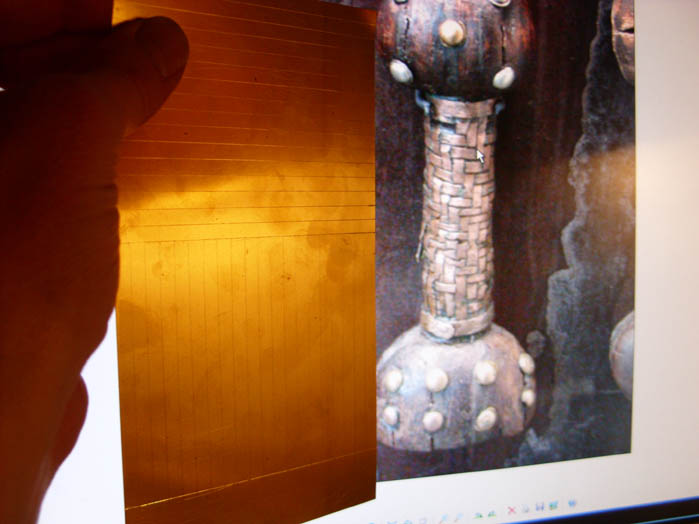
Brass sheet prepared to cut
 Attachment: 91.46 KB Attachment: 91.46 KB
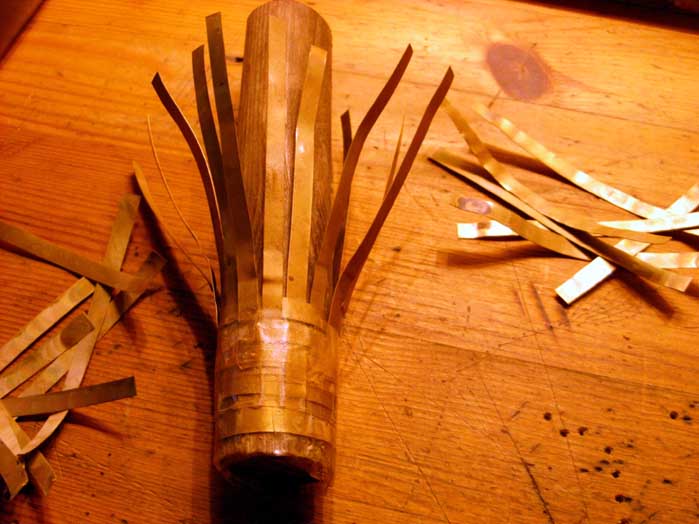
round-weaving
 Attachment: 93.69 KB Attachment: 93.69 KB
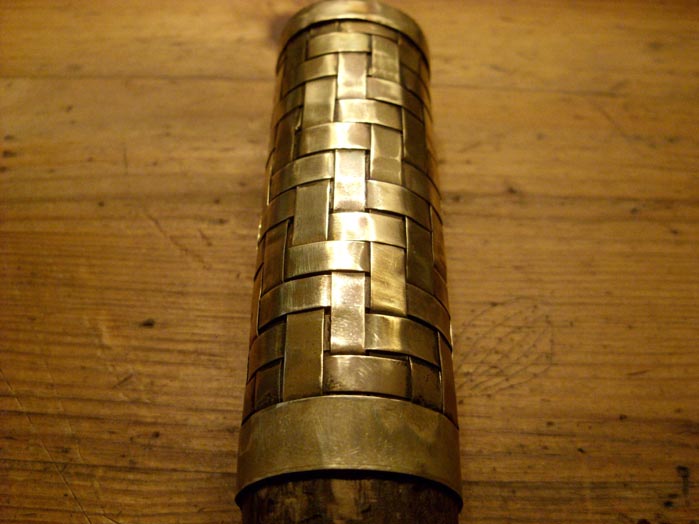
finished thorsbjerg grip
 Attachment: 90.1 KB Attachment: 90.1 KB
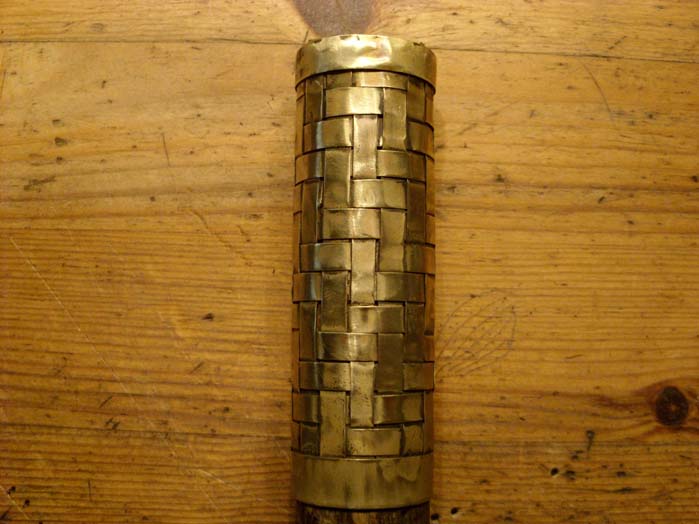
has to be polished
 Attachment: 92.25 KB Attachment: 92.25 KB
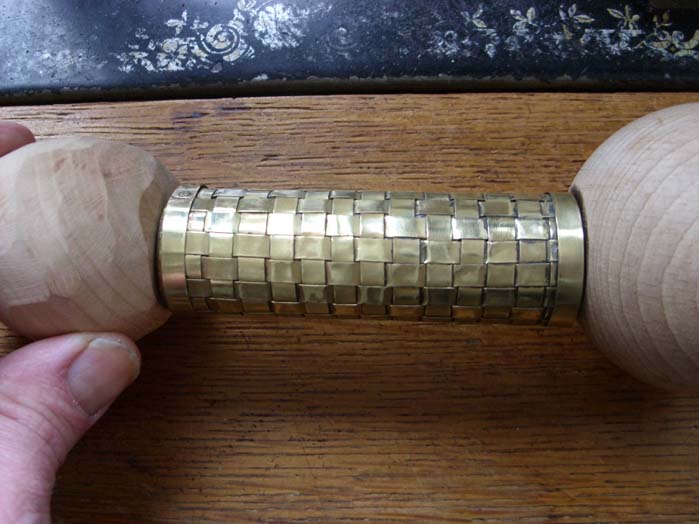
another more simple pattern, just trials
www.archaeoschmiede.de
www.eisenzeithaus.de
Last edited by Christian Böhling on Sun 14 Feb, 2010 5:00 pm; edited 2 times in total
|
|
   |
 |
|
Christian Böhling
Industry Professional
|
 Posted: Sun 14 Feb, 2010 4:52 pm Post subject: Posted: Sun 14 Feb, 2010 4:52 pm Post subject: |
 |
|
| Owen Bush wrote: |
That would still be my best guess , for leather , heavy cloth etc
The British army carry issue sewing kits and I would think equipment fixing paraphernalia would be prevalent in a war party . |
Yes, I thought at this kind of function as well... Also thought at some function for the archers, as these tools seam to be found in quite the same numbers as the longbows....and when I look at the arrows and their extreme long windings of thread to fix tips or feathers I can imagine a function like this: you put a thread through the hole from the end of the head to the neck and then spin it around until it is a thick kind of coil, then spin the other end of the thread a few turns around the arrow shaft and wind thight....but this is a sooo unfinish a thought....the tip could have been used to open a small gap in the feather or when heated a bit for burnishing the coat of pitch... This would explain the strange hole and the tip, but not the octagonal cross-section of the pin and also not the pebbles often found together with this tools..... So strange!!!
Archers here around? What do you think?
www.archaeoschmiede.de
www.eisenzeithaus.de
|
|
   |
 |
Petr Florianek
Industry Professional

|
 Posted: Sun 14 Feb, 2010 11:07 pm Post subject: Posted: Sun 14 Feb, 2010 11:07 pm Post subject: |
 |
|
christian: your thorsberg grip goes great! But i think i am seeing copper on original pic, is that possible? Or may be bronze with high copper ratio. Especialy compared to tacks in pommel...
What do you think?
|
|
   |
 |
|
Christian Böhling
Industry Professional
|
 Posted: Mon 15 Feb, 2010 3:50 am Post subject: Posted: Mon 15 Feb, 2010 3:50 am Post subject: |
 |
|
| Petr Florianek wrote: | christian: your thorsberg grip goes great! But i think i am seeing copper on original pic, is that possible? Or may be bronze with high copper ratio. Especialy compared to tacks in pommel...
What do you think? |
Hi Petr! Conrad Engelhardt describes the grip as "complete hilt of wood, with plaited bronze bands covering the handle proper..." [C.Engelhardt, Denmark in the early ironage]
The restauration of the original is very old, there are many layers of epoxy, and I remember the Nydam-Hall where the originals are exhibited as a room with multiple reflexions, so that it can be a hard job to get good photos.. Maybe that is the reason why it looks like copper on the photo... but all descriptions say brass.
BTW. I am not totally satisfied with it, I think one of my trials was getting too thick and the next too thin...I have to do it for a female hand so I have to find a proportion of the grip which is corresponding with the wooden parts in the way the original is looking like...it was an arithmetical problem to find the number of straps and their optimal width for fitting around the piece of wood I had... and I am soo bad in arithmetics 
The lower wooden part is flattened, not round seen from below, you can´t see this on the photo, it looks more round, but isn´t.
So photos are often not enough. But you can download the original find description from C.Engelhardt of the Thorsberg find here: http://www.archive.org/details/denmarkinearlyir00engeuoft
The .pdf file loading slow, so take your time for a good cup of tea 
There are so many projects I have to work on now but in my workshop it is -5°C! Hope it will get warmer soon.....
www.archaeoschmiede.de
www.eisenzeithaus.de
|
|
   |
 |
|
Peter Johnsson
Industry Professional
|
 Posted: Mon 15 Feb, 2010 6:44 am Post subject: Posted: Mon 15 Feb, 2010 6:44 am Post subject: |
 |
|
To Christian or any one else that may know:
I am looking for decorative artwork of the northern germanic tribes that belongs to the decades around year 1 AD.
Apart from ring dot patterns and "fish-net" carvings or "rope" borders as seen in f.e horn and bone work, are there any other decorative styles?
Zoomorphic? Antropomorphic?
Any cases of early examples of lace work with bands or animals? The earliest examples of decorative knot work that I know of comes from the cut lines of spear shafts from the danish bog finds dated to 2nd & 3rd C AD.
Any help is greatly appreciated!
|
|
   |
 |
|
Christian Böhling
Industry Professional
|
 Posted: Mon 15 Feb, 2010 11:11 am Post subject: Posted: Mon 15 Feb, 2010 11:11 am Post subject: |
 |
|
| Peter Johnsson wrote: | To Christian or any one else that may know:
I am looking for decorative artwork of the northern germanic tribes that belongs to the decades around year 1 AD.
Apart from ring dot patterns and "fish-net" carvings or "rope" borders as seen in f.e horn and bone work, are there any other decorative styles?
Zoomorphic? Antropomorphic?
Any cases of early examples of lace work with bands or animals? The earliest examples of decorative knot work that I know of comes from the cut lines of spear shafts from the danish bog finds dated to 2nd & 3rd C AD.
Any help is greatly appreciated! |
Hello Peter, that is a well known problem! There are some rare examples of artwork, almost of non-germanic origin. One example are those small heads you have seen at the sword scabbard from Nienbüttel (germanic iron-aged weapon thread), which I reconstructed as sword-belt-connections, but they also can be fixations for the leather spur-straps... Maybe the archaeological finds are not yet found or there is a serious reason for that lack of decorations.
I think that decorative artwork seriously started to come up when the germanic elite started to measure themselves with foreign princes copying their signs of wealth (prince of Gommern, 3rd cent., King of Muov, end of 2nd cent.) after the marcomannic wars.....Probably the imitation of living-standards of non-germanic origin were then signs for higher culture and wider political influence of the leaders. The decorations of the 3rd cent. seem to be adaptaions at this "modern age", and in the styles almost influenced from Skyths and still living celtic forms or roman forms. The germanics later developed their own styles out of these when such decorations became more common, also on profane items.
But I think in the 1st cent. the germanics could probably not identify with these later influental cultural appearences, or did not want to. Maybe they saw an outer sign of seperation from rome and others ("don´t wear the enimies colours") in not using such decorations. I think at first it was a question of with whom they wanted to get associated or in other words, a question of being identified as diffenrent from others, when later they wanted to show similarities with others.. Decorative styles as a question of socialization?
I add two pics, the first is from the Nienbüttel sword, the next shows a scabbard end from Illerup Ådal, I made it a bit different from the original, but the animals are as far as I know the earliest of their kind.
 Attachment: 99.02 KB Attachment: 99.02 KB
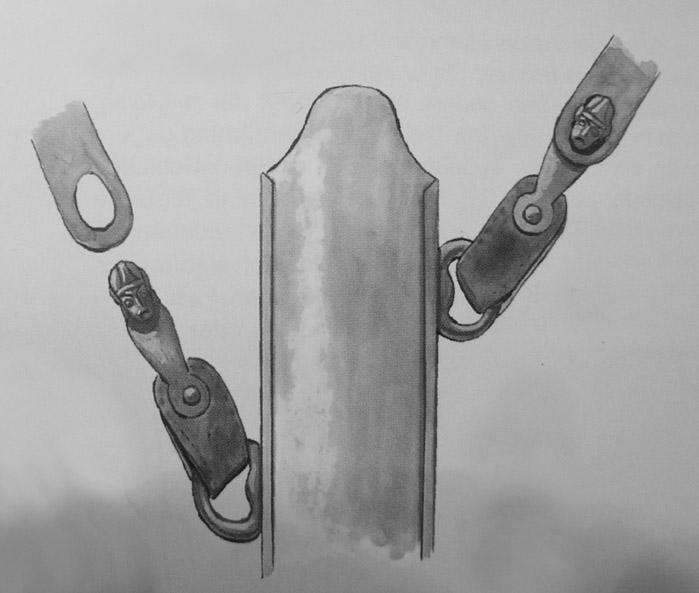
small head sculptures, probably showing either "Mercurius" or celtic warriers with helmets. ca. 10 B.C to 20 A.D
 Attachment: 93.2 KB Attachment: 93.2 KB
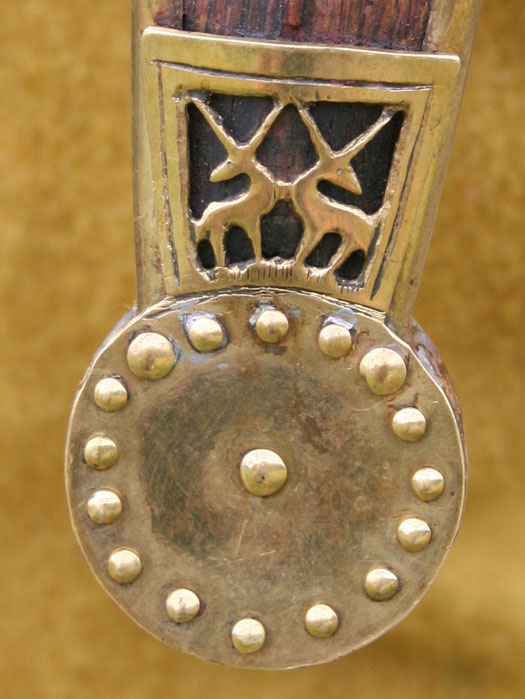
Scabbard-end from Illerup Ådal, ca.200 A.D
www.archaeoschmiede.de
www.eisenzeithaus.de
|
|
   |
 |
|
Peter Johnsson
Industry Professional
|
 Posted: Mon 15 Feb, 2010 4:45 pm Post subject: Posted: Mon 15 Feb, 2010 4:45 pm Post subject: |
 |
|
Christian, thanks for a very good answer.
I had in mind those images from the Gundestrup cauldron. The dating of that artifact is uncertain: 300 BC - 300 AD. I wonder if it might not be rather at the early part than the late in this span.
It is also from south central/eastern Europe. Celtic culture rather than germanic.
I wondered if there were similar imagery going on further north. I see now why I have come up so without real clues to this! :-)
It puts a very interesting light on the early forms of the sword, with these single edged war knives as found in the Hjortsrping find. A world apart! Not much contact with people further away than the baltic sea or rivers east may carry you. Sword shapes in those distant lands has not reached the northern peoples. Instead a pragmatic approach to the wounding blade of war is taken: make a big knife.
A world devoid of much of the fantastic imagery in the richer south. Instead carvings and geometric forms in surface or low relief.
Fascinating!
I´d like to develop these fantasies in more color....
 Attachment: 23.27 KB Attachment: 23.27 KB
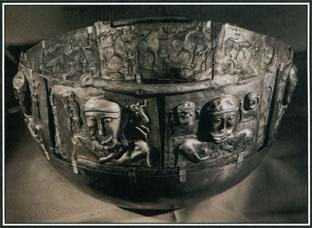
 Attachment: 135.46 KB Attachment: 135.46 KB
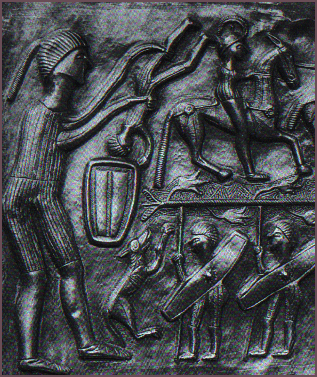
 Attachment: 117.46 KB Attachment: 117.46 KB
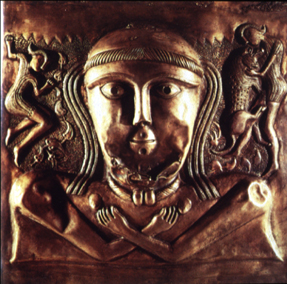
|
|
   |
 |
|
Christian Böhling
Industry Professional
|
 Posted: Tue 16 Feb, 2010 6:06 am Post subject: Posted: Tue 16 Feb, 2010 6:06 am Post subject: |
 |
|
| Peter Johnsson wrote: | Christian, thanks for a very good answer.
I had in mind those images from the Gundestrup cauldron. The dating of that artifact is uncertain: 300 BC - 300 AD. I wonder if it might not be rather at the early part than the late in this span.
It is also from south central/eastern Europe. Celtic culture rather than germanic.
I wondered if there were similar imagery going on further north. I see now why I have come up so without real clues to this! :-)
It puts a very interesting light on the early forms of the sword, with these single edged war knives as found in the Hjortsrping find. A world apart! Not much contact with people further away than the baltic sea or rivers east may carry you. Sword shapes in those distant lands has not reached the northern peoples. Instead a pragmatic approach to the wounding blade of war is taken: make a big knife.
A world devoid of much of the fantastic imagery in the richer south. Instead carvings and geometric forms in surface or low relief.
Fascinating!
I´d like to develop these fantasies in more color.... |
well said, Peter!
There is a questionalbe break between the era of rich influences in the brone-age, when all those beautiful things reached the north without limitations and the days of the iron-age people. When hundreds of years before the seemed to have been so close to the richer south, now they were so far far away. What happened inbetween! New boarders isntead of fluent passages, trade control by the new super-powers, poverty of the north with nothing to trade with that could impress the people of the south enough.... I think the war-time of the celtic tribes in the late LaTéne-periode, germanic tribes or associated tribes on a war-path to the south made an durable interuption of the earlier connections and cut the people from the north from the richer south in a way, only war-campains could fill this gap....robbery instead of trade or to say it with an indian word: dacoity.
One of those "cimbric" cauldrons is mentioned by Tacitus as sent from the Cimbri to rome as sign for the wish for peace! Maybe there have been a couple of such cauldrons beeing robbed during the Cimbric-teutonic migrations in those above metioned uncertain times of the late LaTéne-periode.....After the celtic world had collapsed the main artery was cut and the leaders were cut off supply. So they lost the fundament of their power and had to search for new ways to justifie their claim of power - poverty meant to be powerless....Who is succesful, people ar willing to follow. I think in these times a new leadership developed in the germanic tribes, war-leaders - WARLORDS!!! Maybe that was the era, when a war-god stepped aside a more peaceful god of agroculture, the cult of Wodan, Wotan, Odin was born! And the leaders in times of peace competed the leaders in war-times. And warloards were surrounded by warriors standing outside the normal society, beeing loyal to their chieftains, defending his power if needed agains the people of the own tribe....Maybe that was the way of life of people like Ariovist, Maroboduus or at least Arminius! Prototypes of what we later can see in the viking-chieftains - viking-kings developing to national monarches (if you want so, from Rollo over William Duke of Normandie to the king of England or from Harald Blaatand over Sveinn Tveskegg to the Kingdom of Denmark!
We cannot ignore those mechanisms of social development in interpreting archaeological finds which are involved in those processes - as weapons always have been (when not used to defend the own single farm-house, but when in use in a loyal circle of a warrior-class).
Germanic warlordship comparable to traditions today in parts of east-Africa or Southeast-Asia! An interesting aspect is:
The German Officers of the Colonial Troups could not get angry enough about the African chiefs and their flaky will to cooperate, when the same Germans in the same time on the other hand were soo proud of Arminius (was it not the latter who broke all the rules of beeing loyal and trustful attacking rome in an ambush?) Points of view....To the Gemrnas of the nineteenth century he was the achetype of a freedom-fighter and a symbol of unity and a self-defending Nation when to the old romans he simply was the terrorist of the empire, causing romes greatest desaster. I grew up in a country which national-pride was healthfully broken! This helped much to discover history from a more neutral point of view. History was too often seen in the way the surveyor wanted to see it. Man, now I got philosphic! Sorry!! But you have to know, I live on a battlefield here of which some stupid people last year said: "This is the area where Germany´s history began". I don´t want to found the history of this nation on a mount of human skulls!
My theory is, that those mechanisms also were actual in the ironage, and artwork can tell tales about the political and economical background of a society and their leaders....and seeing ancient weapons or artwork can be very fruitful when we keep all this in mind. So archaeology is philosophy.
Peter, I enjoy discussing with you very much! Hope we will see in person one day!
EDIT: The cauldron of Gundestrup is - following newer surveys in Neuchatel - from the earlier periode - and probably dating in the time of the hjortsprig-find. It could have been a long time in use....interesting is, that this is exact the time, when the offering of humans in the bogs began...and on the cauldron you can see a celtic scene of a human beeing offered by a priest and a circle of warriors are patricipating this scene! Also you can see a warrier on a horse who seems to be above the human reality and a wolve or a dog and ravens flying... That probably are those influences, we can indirectly find in seeing this artwork!! Maybe the Cimbrian leaders were much impressed by this pictures! Did they see Odin on this horse and Huginn and Munin and FenriR in this pictures, did the identify with it? If the couldron could tell us!!!
www.archaeoschmiede.de
www.eisenzeithaus.de
Last edited by Christian Böhling on Tue 16 Feb, 2010 6:24 am; edited 1 time in total
|
|
   |
 |
|
Peter Johnsson
Industry Professional
|
 Posted: Tue 16 Feb, 2010 6:24 am Post subject: Posted: Tue 16 Feb, 2010 6:24 am Post subject: |
 |
|
Yes, this is what makes this period so fascinating. It s a time of something emerging that has likeness to changes in the world of today. Movement in the fringes that thrive on the shortcomings of the established might.
Your words about the Warlord as the Leading Man points at something fundamental that is all too familiar. The cult of the war god...
Yes, I am looking forward to meeting you for certain.
I have yet to visit Kalkriese: it is something I simply have to do. That might be a good opportunity?
|
|
   |
 |
|
Christian Böhling
Industry Professional
|
 Posted: Tue 16 Feb, 2010 6:38 am Post subject: Posted: Tue 16 Feb, 2010 6:38 am Post subject: |
 |
|
| Peter Johnsson wrote: |
I have yet to visit Kalkriese: it is something I simply have to do. That might be a good opportunity? |
I sent a pm. Tell me when you want to come and feel invited!
www.archaeoschmiede.de
www.eisenzeithaus.de
|
|
   |
 |
|
|
You cannot post new topics in this forum
You cannot reply to topics in this forum
You cannot edit your posts in this forum
You cannot delete your posts in this forum
You cannot vote in polls in this forum
You cannot attach files in this forum
You can download files in this forum
|
All contents © Copyright 2003-2024 myArmoury.com — All rights reserved
Discussion forums powered by phpBB © The phpBB Group
Switch to the Basic Low-bandwidth Version of the forum
|

